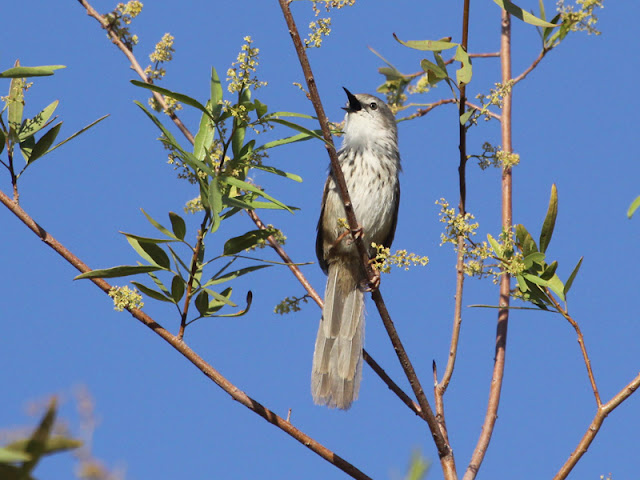 |
| Sunset over Augrabies |
24 Sept 2009 - After several years of trying to get a booking, we finally got accomodation at the Kgalagadi National Park during the school holidays(with a bit help from a friend). The plan was to spend the first night in tents at Augrabies Falls National Park exploring the birds there, then 5 nights in a chalet in the Kgalagadi and then back to Augrabies for another two nights camping.
With Ouma (grandma) in tow we set off from Pretoria early on the morning of the 24th September 2009. I had calculated that it was a good 8 hours drive to Upington which meant a full day behind the wheel. The trip was uneventful and with good roads we reached Augrabies Falls National Park in the late afternoon. I misjudged the distance from Upington to the park, not realising it is an hours drive past where we had to turn off to the Kgalagadi National Park. Along the road to Augrabies I got my first special bird for the trip, a female Pygmy Falcon sitting on the telephone lines next to the road.
 |
| Pygmy Falcon |
These are tiny little raptors, not much bigger than a shrike. They use the Sociable Weaver nests for roosting and nesting and catch and eat the odd weaver as well.
On arrival at the park we booked in and set about making camp, it was very hot and the usual fight broke out while trying to get the tents up.....the campsite at Augrabies is situated under some Karee trees with some grassy stands and is quite shady.
 |
| Augrabies Campsite |
Baboons often stroll through the camp and while we were setting up camp a huge male raided the tent next door by just strolling in and helping himself to whatever was edible. The elderly German couple were quite terrified and sat motionless in their camp chairs while the baboon casually selected some fruit. With broom in hand I headed across to help out but the baboon saw trouble was on the way and he took off without a fight. After a nice barbeque for supper we headed off to bed which consisted of blow up matresses and sleeping bags with blankets for warmth.. In the night it got colder and colder and we had to huddle together for warmth. Eventually dawn arrived and I was sent out into the cold to get hot coffee!!
 |
| Brrrrrrrr |
As soon as I had thawed a bit, I set off to explore the rocky areas north of the campsite. There are patches of reed fringed water here where I had seen Namaqua Warbler on a previous visit. The main goal was to add some photo lifers to my list and the Namaqua Warbler was one of the birds I needed. On the way to the reed bed I was waylaid however with other interesting birds in the form of Orange-river White-eye, Dusky Sunbird, White-throated Canary, Pale-winged Starling, Pied Barbet and Red-eyed Bulbul, all of which were quite open to a quick photo shoot.
 |
| Orange-river White-eye |
 |
| Acacia Pied Barbet |
 |
| Pale-winged Starling |
 |
| Dusky Sunbird |
 |
| White-throated Canary |
Once at the reedbeds, I heard the long trilling calls of the Namaqua Warblers and after a few false alarms where Southern Masked Weavers popped up, I got a Namaqua Warbler to fly up into a small tree still calling its lungs out!!
 |
| Southern Masked Weaver |
 |
| Namaqua Warbler |
Satisfied with my new photo lifers I headed back to camp to collect the family for a walk down to the falls. A walkway has been built to allow people to get close to the falls without fear of falling down the slippery rocks into the gorge below. Occasionally when the Orange river comes down in flood, water levels rise dramatically reaching the restaurant building far above the waterline and these walkways are washed away.
 |
| Wooden walkways |
 |
| Top of the falls where the river starts its plunge into the gorge |
All along the walkways one can see numerous swifts and swallows flying above the gorge, among them are Greater Striped Swallows, Rock Martin and the Alpine Swift.
 |
| Alpine Swift |
The rocks next to the walkways are populated by brightly coloured male Cape Flat Lizards and their drably coloured monochrome mates.
 |
| Cape Flat Lizards |
The second night in the tents was not as cold as the first and when dawn broke on the 25th we packed up to start our journey to the Kgalagadi.....

















No comments:
Post a Comment